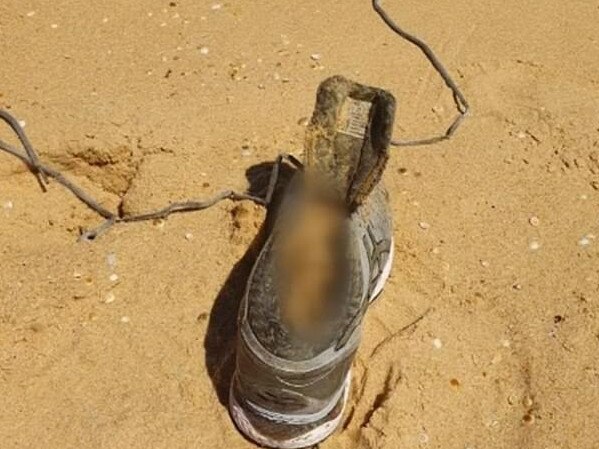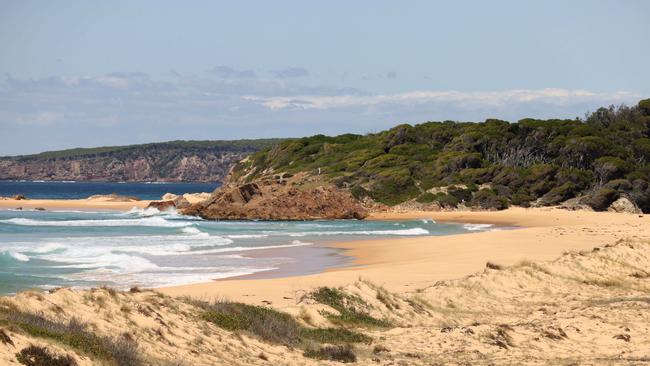Forensic experts examine what we know about Melissa Caddick’s foot, shoe
Top forensic pathologists debunk much of the speculation about the survival of Melissa Caddick’s shoe but remain as intrigued as everyone else about how it was found.
NSW
Don't miss out on the headlines from NSW. Followed categories will be added to My News.
The mysterious and disturbing discovery of the remains of Melissa Caddick’s foot, found still inside her Asics runner three months after she was last seen, has led to wild speculation.
Now forensic pathologists Professor John Hilton and Professor Johan Duflou have spoken to Saturday Extra to share their expert views.
Prof Hilton was the former director of the state government’s Institute of Forensic Medicine and estimates he has conducted more than 15,000 autopsies over the course of his career, including victims of the Bali bombings and the children of convicted killer Kathleen Folbigg.
Over recent months, he too has been intrigued by the story that has gripped Sydney.

Melissa Caddick went missing from her multimillion-dollar home in Dover Heights on November 12, 2020, the morning after authorities raided her home with questions about the misappropriation of more than $20 million.
So far, the Australian Securities and Investments Commission has uncovered an alleged scheme where Caddick hoodwinked friends and family to invest their life savings in return for spectacular returns carefully crafted on bogus statements.
Caddick left behind her keys and phone and with no CCT vision available, police first theorised the 49-year-old mother of one was possibly still alive and on the run.

Then her shoe, with a decomposed foot inside, washed up at Bournda Beach, near Tathra on February 21.
Scientists extracted DNA and matched it to DNA from the missing fraudster’s toothbrush.
While many have wondered how human remains could still be intact inside a shoe after three months in the water, Prof Hilton said it was possible, despite the ocean being filled with predators and scavengers.
“You can get recognisable body parts after a few months in the ocean. It is not the thing you’d necessarily expect, nor do you see it often, but it can happen,” Prof Hilton said.
“There is not a great deal of flesh on the human foot but the bones can be intact because they are held together by ligaments and ligaments are pretty tough and resistant to decomposition, and the neoprene of the shoe would, to some extent, protect from the depredation of the wildlife.”
He did not agree with suggestions that the shoe would have had barnacles on it if it had indeed been in the water for 12 weeks.
“Well it depends on the nature of the chemical composition of the shoe and whether barnacles favour it or not,” he said.

Prof Duflou, who also once ran the NSW Department of Forensic Medicine and conducted an average of 200 autopsies a year, agreed shoes were remarkably protective.
“With skeletons, if a person is wearing shoes, the entire foot remains in the shoe, it can either mummify or progress to skeletonised, but you commonly find feet in shoes in very decomposed cases and, as is the way with feet and shoes, they can be separated from the rest of the body,” he said.

Police have raised the possibility Caddick took her own life soon after the raid at the cliffs at Dover Heights.
What both professors find strange is the fact the foot, and nothing else, was found 400km south of where Mrs Caddick presumably went missing that morning of November 12.
“That is remarkable but it can happen,” Prof Hilton said.
“There is the east coast current which runs north to south most of the year and is quite strong, so it doesn’t astonish me that much, but what astonishes me is they found it at all. The coast is ginormous and the ocean ever more so, and so why would it come bobbing up on that particular beach at that time.”

NSW Police Assistant Commissioner Mick Willing said at the time of the gruesome discovery that police modelling of current drifts and waves showed it was possible Caddick entered the water from near her clifftop home and her body drifted several hundred kilometres south.
But Prof Hilton has wondered whether something more sinister may have happened.
Did she die closer to where the foot was found?
“There are all sorts of bizarre stories, including dismemberment with bits and piece thrown in the ocean much closer to where the foot washed up,” he said.

Professor Duflou agreed there is a possibility Caddick’s body was moved.
“The two major possibilities is she jumped around Dover Heights in November or somehow she ended up close to where the foot was found,” he said.
“I would have thought it was relatively unlikely the entire body would go that far and remain intact, but whether a shoe can or not, I don’t know.
“I was surprised a sole foot would land that far away from Dover Heights, but you see strange things sometimes, but I would not exclude, with the foot found where it was, that the body may have been closer to where the foot was found to begin with but having a good look around where the foot was found would not be the worst idea by police.”
More Coverage
Originally published as Forensic experts examine what we know about Melissa Caddick’s foot, shoe




